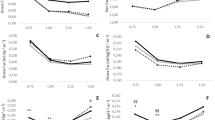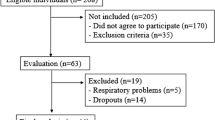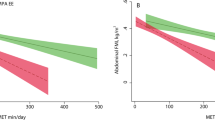Abstract
Background:
Obesity is associated with reduced exercise maximal fat oxidation rate (FATmax), which is generally assessed by cardiopulmonary cycling test. The six-minute walking test (6MWT) presents an alternative method in patients.
Objective:
The aim of this study was to establish a practical reference equation facilitating the prediction of FATmax from the 6MWT in obese children of both genders.
Design:
This study is a cross-sectional study using mixed linear and multiple regression models.
Research methods and procedures:
Anthropometric measurements were recorded and submaximal cycling test and 6MWT conducted for 131 school-aged obese children, 68 boys and 63 girls. A multiple regression analysis for FATmax, including six-minute walking distance (6MWD), anthropometric and cardiac parameters as the dependent variables, was performed for the two genders separately.
Results:
Mean 6MWD and FATmax were 564.9±53.7 m and 126.5±12.1 mg min−1 for boys and 506.7±55.0 m and 120.7±10.0 mg min−1 for girls, respectively. The 6MWD, body mass index, Z-score, fat-free mass, waist and hip circumferences (WC and HC), rest heart rate, and systolic and diastolic blood pressures were highly correlated with FATmax for both genders. There was a significant correlation between 6MWD and FATmax in both boys and girls (r=0.88 and r=0.81, P<0.001, respectively). Stepwise regression analyses revealed that the combinations of 6MWD with HC for boys and 6MWD with WC for girls improved the predictability of the model (R2=0.81 for boys and R2=0.72 for girls; P<0.001).
Conclusion:
In obese children, the 6MWT can be used to predict FATmax when formal test of exercise capacity and gas exchange analysis are unavailable or impractical. It is therefore possible to prescript targeted exercises at FATmax, without performing indirect calorimetry, just from a field test.
This is a preview of subscription content, access via your institution
Access options
Subscribe to this journal
Receive 12 print issues and online access
$259.00 per year
only $21.58 per issue
Buy this article
- Purchase on Springer Link
- Instant access to full article PDF
Prices may be subject to local taxes which are calculated during checkout

Similar content being viewed by others
References
Speiser PW, Rudolf MC, Anhalt H, Camacho-Hubner C, Chiarelli F, Eliakim A et al. Childhood obesity. J Clin Endocrinol Metab 2005; 90: 1871–1887.
Pérez-Martin A, Dumortier M, Raynaud E, Brun JF, Fédou C, Bringer J et al. Balance of substrate oxidation during submaximal exercise in lean and obese people. Diabetes Metab 2001; 27: 466–474.
Kimm SY, Glynn NW, Obarzanek E, Kriska AM, Daniels SR, Barton BA et al. Relation between the changes in physical activity and body-mass index during adolescence: a multicentre longitudinal study. Lancet 2005; 366: 301–307.
Norman AC, Drinkard B, McDuffie JR, Ghorbani S, Yanoff LB, Yanovski JA . Influence of excess adiposity on exercise fitness and performance in overweight children and adolescents. Pediatrics 2005; 115: e690–e696.
Caprio S, Tamborlane W . Metabolic impact of obesity in childhood. Endocrinol Metab Clin North Am 1999; 28: 731–747.
Brandou F, Dumortier M, Garandeau P, Mercier J, Brun JF . Effects of two-month rehabilitation program on substrate utilization during exercise in obese adolescents. Diabetes Metab 2003; 29: 20–27.
Lazzer S, Boirie Y, Poissonnier C, Petit I, Duché P, Taillardat M et al. Longitudinal changes in activity patterns, physical capacities, energy expenditure, and body composition in severely obese adolescents during a multidisciplinary weight-reduction program. Int J Obes 2005; 29: 37–46.
Maffeis C, Castellani M . Physical activity: an effective way to control weight in children. Nutr Metab Cardiovasc Dis 2007; 17: 394–408.
Brambilla P, Pozzobon G, Pietrobelli A . Physical activity as the main therapeutic tool for metabolic syndrome in childhood. Int J Obes 2011; 35: 16–28.
Ben Ounis O, Elloumi M, Zouhal H, Makni E, Lac G, Tabka Z et al. Effect of an individualized physical training program on resting cortisol and growth hormone levels and fat oxidation during exercise in obese children. Ann Endocrinol 2011; 72: 34–41.
Brooks GA, Mercier J . Balance of carbohydrate and lipid utilization during exercise: the “crossover” concept. J Appl Physiol 1994; 76: 2253–2261.
Elloumi M, Ben Ounis O, Makni E, Van Praagh E, Tabka Z, Lac G . Effect of individualized weight-loss programmes on adiponectin, leptin and resistin levels in obese adolescent boys. Acta Paediatr 2009; 98: 1487–1493.
Hamilton DM, Haennel RG . Validity and reliability of the 6-minute walk test in a cardiac rehabilitation population. J Cardiopulm Rehabil 2000; 20: 156–164.
Rasekaba T, Lee AL, Naughton MT, Williams TJ, Holland AE . The six-minute walk test: a useful metric for the cardiopulmonary patient. Intern Med J 2009; 39: 495–501.
Elloumi M, Makni E, Ounis OB, Moalla W, Zbidi A, Zaoueli M et al. Six-minute walking test and the assessment of cardiorespiratory responses during weight-loss programmes in obese children. Physiother Res Int 2011; 16: 32–42.
Geiger R, Strasak A, Treml B, Gasser K, Kleinsasser A, Fischer V et al. Six-minute walk test in children and adolescents. J Pediatr 2007; 150: 395–399, 399.e1–2.
Lesser DJ, Fleming MM, Maher CA, Kim SB, Woo MS, Keens TG . Does the 6-min walk test correlate with the exercise stress test in children? Pediatr Pulmonol 2010; 45: 135–140.
Solway S, Brooks D, Lacasse Y, Thomas S . A qualitative systematic overview of the measurement properties of functional walk tests used in the cardiorespiratory domain. Chest 2001; 119: 256–270.
Moalla W, Gauthier R, Maingourd Y, Ahmaidi S . Six-minute walking test to assess exercise tolerance and cardiorespiratory responses during training program in children with congenital heart disease. Int J Sports Med 2005; 26: 756–762.
Morinder G, Mattsson E, Sollander C, Marcus C, Larsson UE . Six-minute walk test in obese children and adolescents: reproducibility and validity. Physiother Res Int 2009; 14: 91–104.
Cahalin LP, Mathier MA, Semigran MJ, Dec GW, DiSalvo TG . The six minute walk test predicts peak oxygen uptake and survival in patients with advanced heart failure. Chest 1996; 110: 325–332.
Carter R, Holiday DB, Stocks J, Grothues C, Tiep B . Predicting oxygen uptake for men and women with moderate to severe chronic obstructive pulmonary disease. Arch Phys Med Rehabil 2003; 84: 1158–1164.
Ferris BG . Epidemiology standardisation project II. Recommended respiratory disease questionnaire for use with adults and children in epidemiological research. Am Rev Respir Dis 1978; 118: 7–53.
Rolland-Cachera MF, Cole TJ, Sempe M, Tichet J, Rossignol C, Charraud A . Body mass index variations: centiles from birth to 87 yearth. Eur J Clin Nutr 1991; 45: 13–21.
Slaughter MH, Lohman TG, Boileau RA, Horswill CA, Stillman RJ, VanLoan MD . Skinfold equation for estimation of body fatness in children and youth. Hum Biol 1988; 60: 709–723.
Tanner JM, Whitehouse RH, Takaishi M . Standards from birth to maturity for height, weight, height velocity, and weight velocity: British children 1965 II. Arch Dis Child 1966; 41: 613–635.
American Thoracic Society (ATS). ATS statement: Guidelines for the six-minute walk test. Am J Respir Crit Care Med 2002; 166: 111–117.
Borg GA . Psychophysical bases of perceived excretion. Med Sci Sports Exerc 1982; 14: 377–381.
Wasserman K, Hansen J, Whipp B . Principles of Exercise Testing and Interpretation. Febiger: Philadelphia, 1986. pp 50–80.
Aucouturier J, Rance M, Meyer M, Isacco L, Thivel D, Fellmann N et al. Determination of the maximal fat oxidation point in obese children and adolescents: validity of methods to assess maximal aerobic power. Eur J Appl Physiol 2009; 105: 325–331.
Enright PL, Sherrill DL . Reference equations for the six-minute walk in healthy adults. Am J Respir Crit Care Med 1998; 158: 1384–1387.
Du H, Newton PJ, Salamonson Y, Carrieri-Kohlman VL, Davidson PM . A review of the six-minute walk test: its implication as a self-administered assessment tool. Eur J Cardiovasc Nurs 2009; 8: 2–8.
Guyatt GH, Sullivan MJ, Thompson PJ, Fallen EL, Pugsley SO, Taylor DW et al. The 6-minute walk: a new measure of exercise capacity in patients with chronic heart failure. Can Med Assoc J 1985; 132: 919–923.
Wijkstra PJ, TenVergert EM, van der Mark TW, Postma DS, Van Altena R, Kraan J et al. Relation of lung function, maximal inspiratory pressure, dyspnoea, and quality of life with exercise capacity in patients with chronic obstructive pulmonary disease. Thorax 1994; 49: 468–472.
Nordby P, Saltin B, Helge JW . Whole-body fat oxidation determined by graded exercise and indirect calorimetry: a role for muscle oxidative capacity? Scand J Med Sci Sports 2006; 16: 209–214.
Bordenave S, Metz L, Flavier S, Lambert K, Ghanassia E, Dupuy AM et al. Training-induced improvement in lipid oxidation in type 2 diabetes mellitus is related to alterations in muscle mitochondrial activity. Effect of endurance training in type 2 diabetes. Diabetes Metab 2008; 34: 162–168.
Michallet AS, Tonini J, Regnier J, Guinot M, Favre-Juvin A, Bricout V et al. Methodological aspects of crossover and maximum fat-oxidation rate point determination. Diabetes Metab 2008; 34: 514–523.
Savva SC, Tornaritis M, Savva ME, Kourides Y, Panagi A, Silikiotou N et al. Waist circumference and waist-to-height ratio are better predictors of cardiovascular disease risk factors in children than body mass index. Int J Obes Relat Metab Disord 2000; 24: 1453–1458.
Huxley R, Mendis S, Zheleznyakov E, Reddy S, Chan J . Body mass index, waist circumference and waist:hip ratio as predictors of cardiovascular risk—a review of the literature BMI, WC and WHR as predictors of cardiovascular risk. Eur J Clin Nutr 2010; 64: 16–22.
Ingle L, Reddy P, Clark AL, Cleland JG . Diabetes lowers six-minute walk test performance in heart failure. J Am Coll Cardiol 2006; 47: 1909–1910.
Acknowledgements
This study was supported by the Ministry of Higher Education and Scientific Research of Tunisia. We thank adolescents and their parents for their strong cooperation and availability.
Author information
Authors and Affiliations
Corresponding author
Ethics declarations
Competing interests
The authors declare no conflict of interest.
Rights and permissions
About this article
Cite this article
Makni, E., Moalla, W., Trabelsi, Y. et al. Six-minute walking test predicts maximal fat oxidation in obese children. Int J Obes 36, 908–913 (2012). https://doi.org/10.1038/ijo.2011.257
Received:
Revised:
Accepted:
Published:
Issue Date:
DOI: https://doi.org/10.1038/ijo.2011.257



